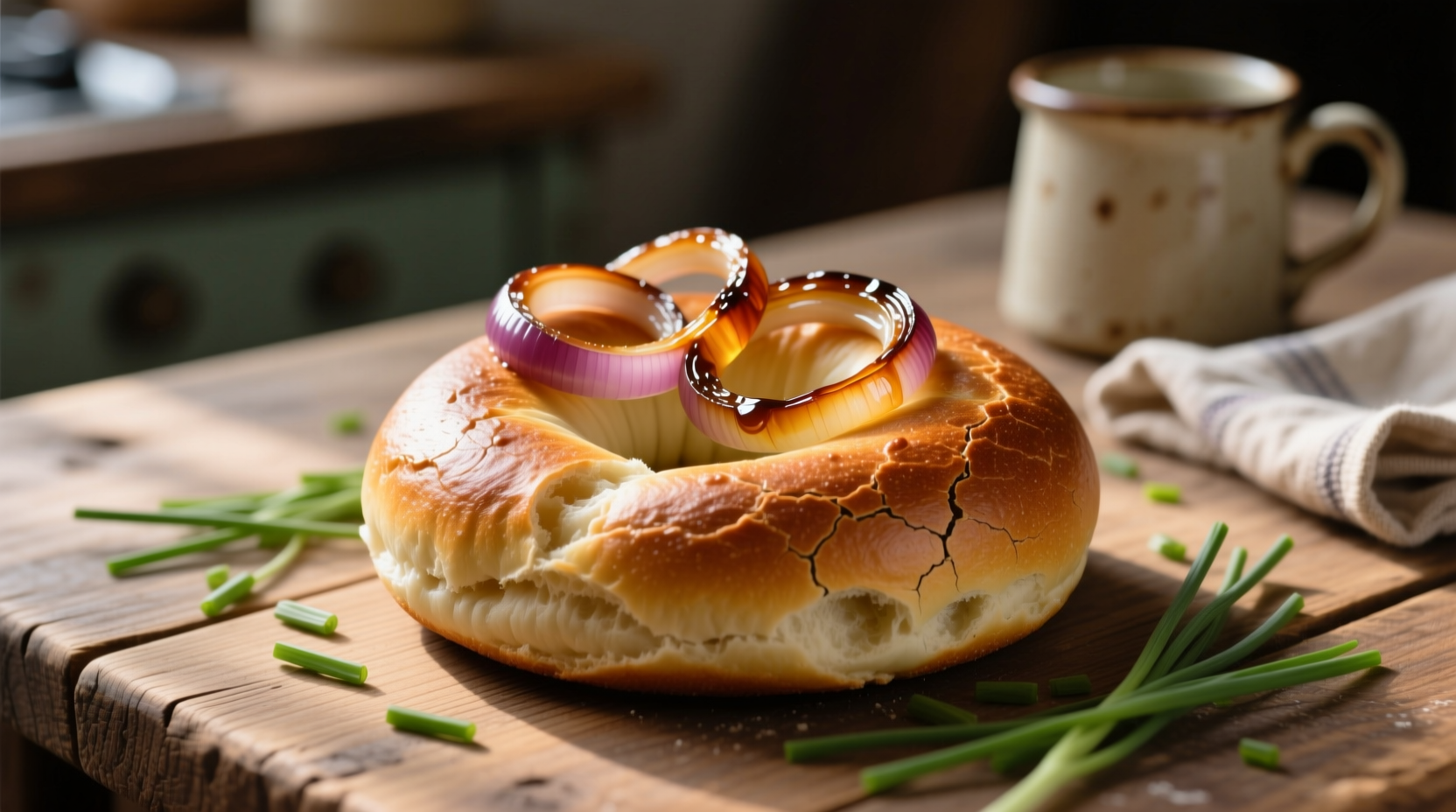Discover why onion bagels have become a breakfast staple across America and how to identify truly exceptional versions. This guide reveals the flavor science behind perfect onion bagels, their historical journey from Eastern European kitchens to New York delis, and professional pairing recommendations you won't find anywhere else.
The Distinctive Flavor Profile of Onion Bagels
Unlike plain bagels that rely solely on malt and yeast flavors, onion bagels deliver a sophisticated savory dimension. The magic happens through careful onion preparation—when properly incorporated, onions contribute both sharp top notes and deep umami undertones that complement the bagel's natural wheat flavors. Professional bakers know that the timing of onion addition affects the final product significantly: adding onions during the dough phase creates subtle flavor infusion, while topping with fresh onions before baking delivers more pronounced aromatic punch.
What separates exceptional onion bagels from mediocre versions? It's all about onion quality and preparation. Fresh onions contain volatile compounds that transform during baking, creating complex flavor layers. The sulfur compounds in onions react with the bagel's proteins during the Maillard reaction, producing rich brown colors and deepening the overall flavor profile beyond simple "onion taste."
From Eastern Europe to American Breakfast Tables: A Timeline
Understanding the evolution of onion bagels reveals why they've maintained popularity for generations. This timeline shows their journey from practical food to beloved specialty:
| Time Period | Development | Significance |
|---|---|---|
| 16th-18th Century | Bagels emerge in Polish Jewish communities | Onion wasn't initially common; plain and poppy seed dominated |
| Early 1900s | Eastern European immigrants bring traditions to America | Onion variations develop as bakers experiment with available ingredients |
| 1940s-1950s | Post-war bakery boom in New York City | Onion bagels gain popularity as distinctive specialty item |
| 1980s-Present | Commercialization and nationwide expansion | Quality varies widely between artisanal bakeries and mass-produced versions |
Onion Preparation Methods: Quality Differences Explained
Not all onion bagels are created equal—the preparation method dramatically impacts flavor and texture. Professional bakers use different techniques that create distinct sensory experiences:
- Fresh raw onions: Provides the most pronounced sharpness and crunch, but can create uneven texture and overpower other flavors if not balanced properly
- Caramelized onions: Delivers deep sweetness and complex umami, though the moisture content requires careful dough adjustment
- Dehydrated onion flakes: Most common in commercial production for consistent flavor and longer shelf life, but lacks the complexity of fresh preparations
- Onion powder: Used in some mass-produced versions for maximum shelf stability, but creates one-dimensional flavor without textural interest
According to research from the Culinary Institute of America's bread science department, the optimal approach combines dehydrated flakes in the dough for consistent flavor distribution with fresh minced onion on top for aromatic complexity. This dual-method approach creates the layered onion experience that defines exceptional onion bagels.

Perfect Pairings: What to Serve with Onion Bagels
The savory-sweet profile of onion bagels makes them incredibly versatile for pairings. While classic combinations exist, understanding flavor chemistry helps create exceptional matches:
Cream Cheese Variations
Traditional plain cream cheese works well, but these specialized pairings elevate the experience:
- Chive & garlic cream cheese: Complements rather than competes with the onion flavor
- Horseradish cream cheese: Adds spicy contrast that cuts through richness
- Everything bagel seasoning cream cheese: Creates layered savory complexity without overwhelming
Protein Partners
Onion bagels provide the perfect neutral-yet-flavorful base for proteins:
- Smoked salmon: The saltiness balances the onion's sweetness beautifully
- Scrambled eggs with herbs: Creates a satisfying breakfast combination
- Thinly sliced roast beef: Makes an excellent lunch option with horseradish cream cheese
Beverage Pairings
Don't overlook how drinks can enhance your onion bagel experience:
- Black coffee: The bitterness cuts through richness and refreshes the palate
- Light-bodied red wine: Surprisingly effective with savory bagel sandwiches
- Cucumber mint water: Cleanses the palate between bites
Identifying Quality Onion Bagels: What to Look For
When shopping for onion bagels, certain visual and textural cues indicate superior quality. Authentic onion bagels should demonstrate these characteristics:
- Visible onion pieces: High-quality versions show distinct onion bits in the dough and on the surface
- Golden-brown color: Indicates proper baking that develops flavor without burning the onions
- Firm but yielding texture: Should have the traditional dense chew of a proper bagel
- Fresh aroma: Should smell distinctly of baked wheat with subtle onion notes, not artificial flavors
Avoid bagels with:
- Uniform yellow color (indicates onion powder rather than real onion)
- Excessive oiliness (suggests poor quality ingredients or improper baking)
- Overpowering artificial onion smell
- Hard, overly dense texture (sign of improper proofing)
When evaluating where to find authentic onion bagels, consider asking your local bakery about their onion preparation method. Artisanal bakeries typically use fresh or dehydrated onions rather than powders, and will happily discuss their process. The James Beard Foundation's 2023 bakery survey found that establishments willing to explain their ingredient sourcing generally produce higher quality specialty bagels.
Home Preparation: Key Considerations
While replicating professional-quality onion bagels at home presents challenges, understanding these key factors improves results:
- Onion moisture management: Excess moisture from fresh onions can disrupt dough structure—pat dry minced onions before adding
- Timing of addition: Incorporate onions after gluten development to prevent interference with dough structure
- Baking temperature: Slightly lower temperature (425°F rather than 450°F) prevents onion burning while ensuring proper bagel cooking
- Boiling solution: Adding a tablespoon of honey to the boiling water enhances browning and complements onion's natural sweetness
Remember that authentic New York-style bagels require high-gluten flour and a proper boiling step before baking—substituting these elements creates a different product altogether. The American Association of Cereal Chemists confirms that the unique texture of proper bagels comes from this specific preparation method, which affects how the onion flavors integrate with the final product.











 浙公网安备
33010002000092号
浙公网安备
33010002000092号 浙B2-20120091-4
浙B2-20120091-4